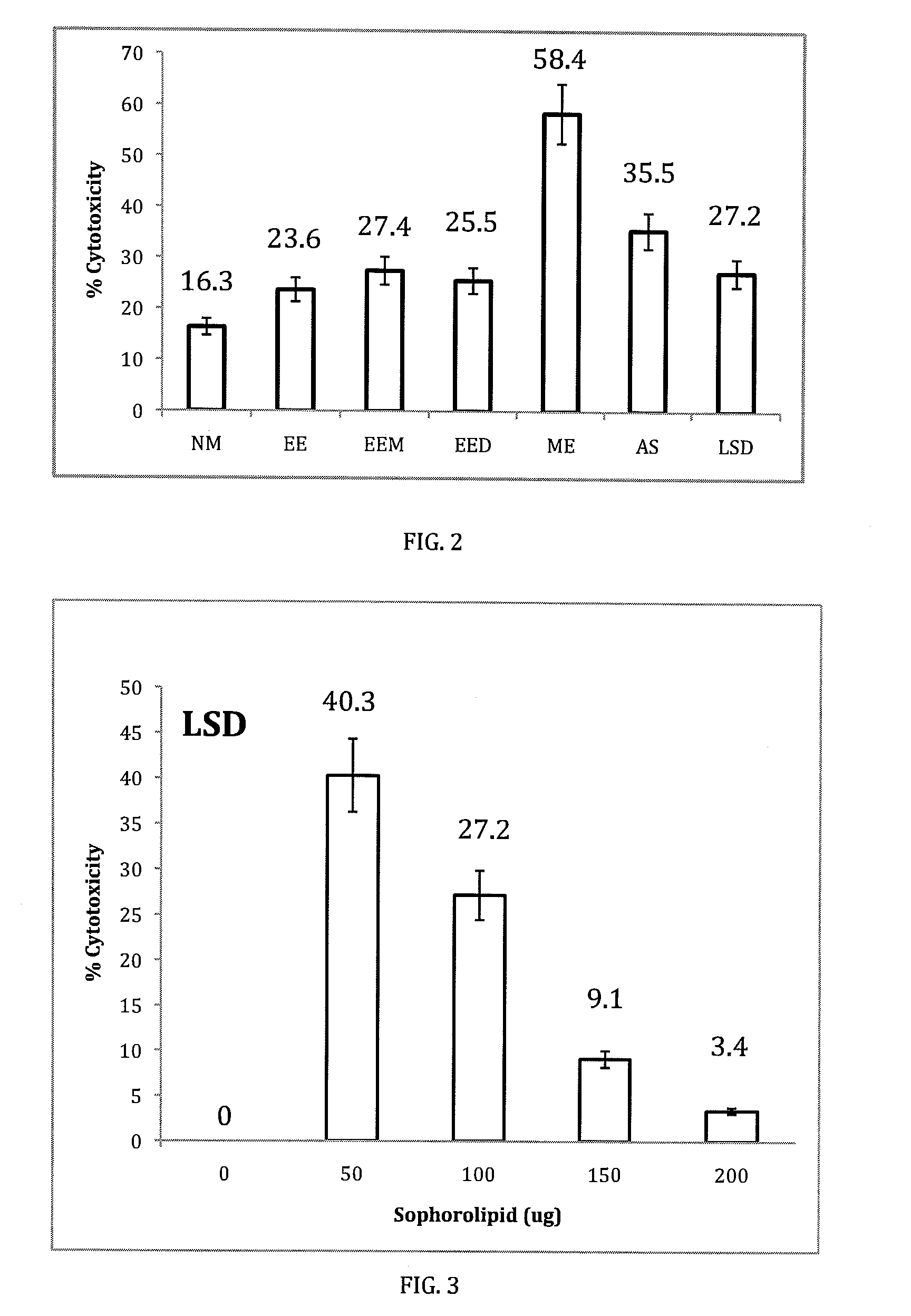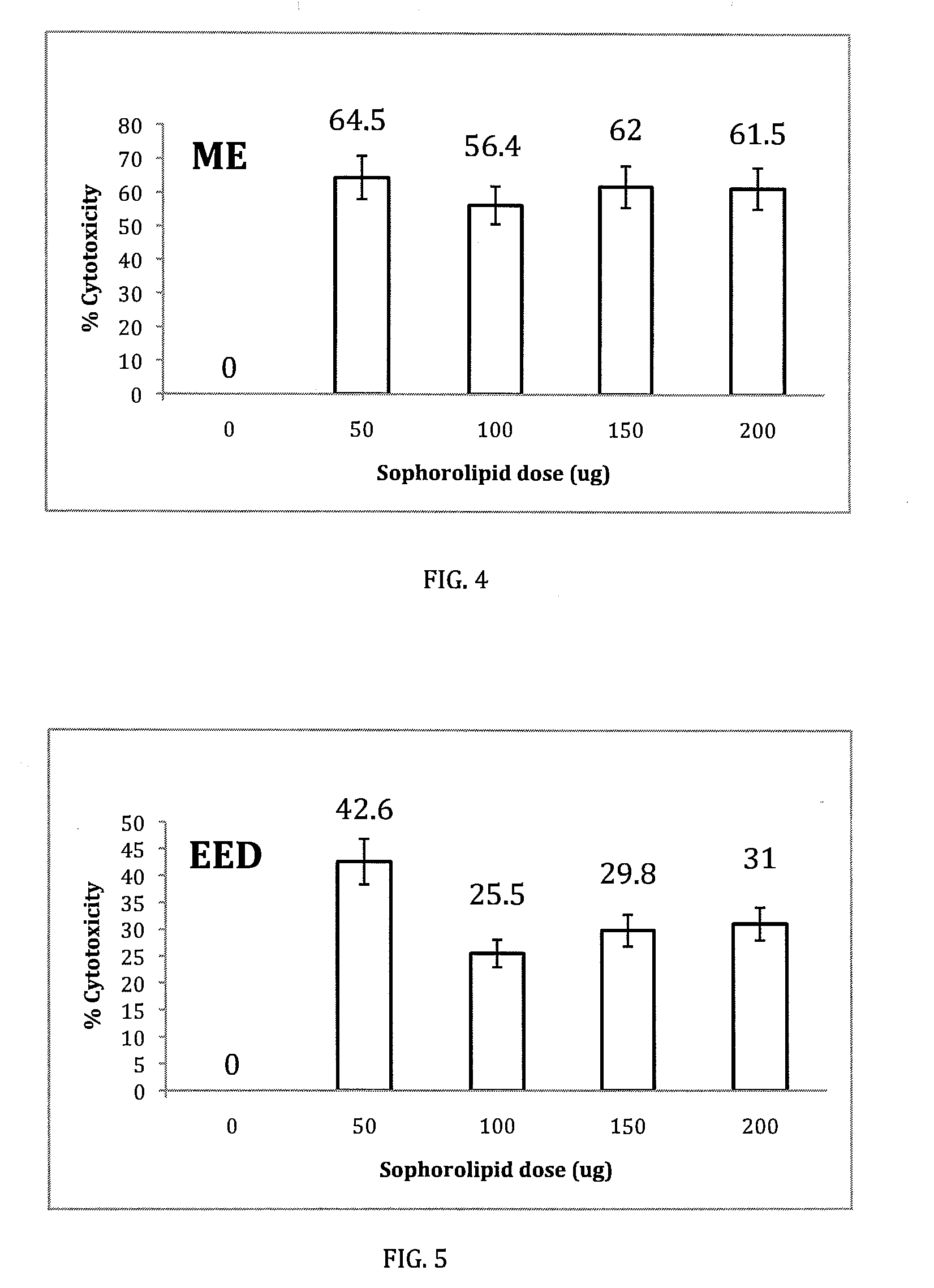Treatment and prophylaxis of cancer
a cancer and prophylaxis technology, applied in the field of sophorolipids, can solve the problems of no treatment that significantly impacts the death toll, the risk of the more common varieties is increasing with age, and the treatment is not effective, so as to reduce the sepsis-related mortality and inflammatory cytokine production, reduce the risk of the more common varieties, and reduce the side effects.
- Summary
- Abstract
- Description
- Claims
- Application Information
AI Technical Summary
Benefits of technology
Problems solved by technology
Method used
Image
Examples
example 1
Summary
[0033]The sophorolipid mixtures of the present invention have anti cancer properties, which were confirmed by experiment and observations. Human pancreatic carcinoma (HPAC) cells (1×104 / ml) were treated with increasing concentrations (0.5, 1.0, 1.5, and 2.0 mg / ml) of a sophorolipid natural mixture and six select sophorolipid derivatives (ethyl ester, ethyl ester monacetate, ethyl ester diacetate, methyl ester, acidic sophorolipid, lactonic sophorolipid diacetate) for 24 hours and were assessed for cell necrosis (cytoxicity—LDH release) and apoptosis (annexin). Controls consisted of cells treated with media or vehicle alone and sophorolipids treatment of peripheral blood mononuclear cells (PBMC). AS mediated toxicity was inversely proportional with dose (LSD—40.3% at 0.5 mg / ml, 3.4% at 2.0 mg / ml, AS 49% at 0.5 mg / ml, 0% at 2.0 mg / ml). Dose dependant apoptosis could be observed with the AS derivative. Sophorolipid treatment did not effect PBMC at all doses tested.
Materials and ...
example 2
[0049]Data demonstrates that sophorolipids are non-toxic in animal models at various doses. These results are shown in Appendix C.
[0050]Various cell lines including hey (ovarian), T47D (breast), LNCAP & PC-3 (both prostate), U266 (multiple myeloma) were tested. In order to ascertain the toxicity of sophorolipids, cells were ground in a NL media (100 mL / well at 20000 cells / mL) and were allowed to adhere for about 6-18 hours. Test samples were treated with a natural sophorolipid or sophorolipid derivative in an amount of about 0.1-40 mM (100 mL / well) and a control sample was established. The test sample and the control sample were monitored after 48 to 96 hours by SRB staining (protein) and with an ELISA reader at 570 nm. Before the drug media of adherent cells was replaced with serum free media, an additional 24 hours of incubation and an additional amount of drug was added at 0.1-10 mM. As shown in Appendix C, most cancer cell lines demonstrated increased cell death and / or apoptosis...
PUM
| Property | Measurement | Unit |
|---|---|---|
| concentrations | aaaaa | aaaaa |
| concentrations | aaaaa | aaaaa |
| concentrations | aaaaa | aaaaa |
Abstract
Description
Claims
Application Information
 Login to View More
Login to View More - R&D
- Intellectual Property
- Life Sciences
- Materials
- Tech Scout
- Unparalleled Data Quality
- Higher Quality Content
- 60% Fewer Hallucinations
Browse by: Latest US Patents, China's latest patents, Technical Efficacy Thesaurus, Application Domain, Technology Topic, Popular Technical Reports.
© 2025 PatSnap. All rights reserved.Legal|Privacy policy|Modern Slavery Act Transparency Statement|Sitemap|About US| Contact US: help@patsnap.com



